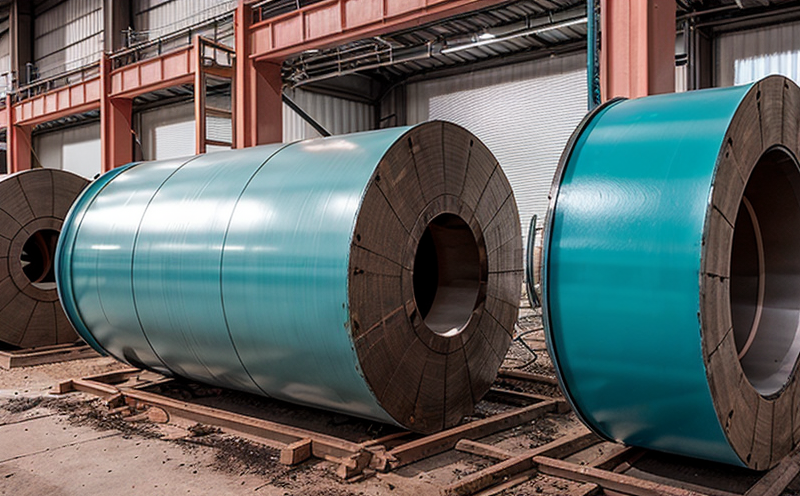JIS H8502 Salt Spray Corrosion Testing
The JIS H8502 salt spray test is a critical procedure used in industrial manufacturing and processing to evaluate the corrosion resistance of materials, coatings, and surface treatments. This test simulates real-world environmental conditions by exposing specimens to a highly corrosive atmosphere created through a neutral salt mist. It is widely recognized for its stringent requirements and is an essential part of quality assurance programs aimed at ensuring product durability and reliability in harsh environments.
The JIS H8502 standard, developed by the Japanese Industrial Standards Committee (JISC), specifies detailed parameters that govern the test setup, duration, and assessment criteria. The salt solution used typically contains 5% sodium chloride dissolved in distilled water, adjusted to a pH of 6.5 ± 0.2 with acetic acid if necessary. Specimens are placed inside a closed chamber where they are continuously exposed to this corrosive atmosphere for extended periods.
The test duration varies depending on the material being evaluated. For instance, metals like steel may require up to 168 hours of continuous exposure, whereas other materials might need shorter durations based on their expected service life and anticipated environmental conditions. The purpose is to observe any signs of rust formation, degradation, or loss in adhesion between coatings and substrates.
During the test, it's crucial for laboratories to adhere strictly to JIS H8502 specifications regarding chamber temperature (35°C ± 1°C), humidity levels within the chamber, and airflow patterns. Compliance with these conditions ensures accurate results that can be reliably compared across different manufacturers or batches of products.
After completing the prescribed exposure time, specimens are inspected visually for changes indicative of corrosion such as pitting, discoloration, or complete failure of the protective layer. In some cases, additional destructive testing methods may also be employed to quantify the extent of damage more precisely.
The JIS H8502 salt spray test is particularly relevant in industries where materials are exposed to salty environments for extended periods, such as maritime construction, offshore oil drilling rigs, and coastal infrastructure projects. By identifying potential weaknesses early on through this testing process, manufacturers can implement necessary improvements before products reach market.
- Maritime Construction
- Offshore Oil Drilling Rigs
- Cochlear Implants (where durability under saline conditions is crucial)
- Civil Engineering Projects near Coastlines
Scope and Methodology
The JIS H8502 salt spray test follows a standardized procedure designed to simulate the corrosive effects of salt exposure on materials used in various industries. Here’s how it works:
- Prepare specimens according to specified dimensions and tolerances.
- Ensure all equipment meets JIS H8502 requirements, including chamber size, humidity control system, and airflow distribution.
- Adjust the salt solution’s pH level correctly before starting the test.
- Place specimens inside a closed chamber filled with the prepared salt mist at 35°C ± 1°C.
- Exposure duration depends on the material being tested; standard times range from 96 to 168 hours.
- Monitor temperature, humidity, and airflow during the entire testing period.
- Inspect specimens after reaching the designated exposure time for signs of corrosion or degradation.
This meticulous approach guarantees that every aspect of the test adheres to international standards set by JISC. This ensures consistency in results regardless of where they are conducted around the world. Additionally, this method allows manufacturers to identify problem areas early on so corrective actions can be taken before products reach consumers.
Industry Applications
- Metallurgy: Testing of metallic components used in automotive manufacturing, heavy machinery, and transportation sectors where salt exposure is common.
- Petrochemicals: Evaluation of pipelines and storage tanks exposed to brackish water or sea spray.
- Marine Engineering: Assessment of structural elements like hull plates, propellers, and anchors subjected to extensive seawater contact.
- Civil Infrastructure: Durability studies on concrete structures located along coastlines exposed to salt-laden winds.
Environmental and Sustainability Contributions
The JIS H8502 salt spray test plays a vital role in promoting sustainable practices by helping manufacturers develop more durable products that can withstand harsh environmental conditions without frequent replacements. By identifying materials or coatings susceptible to early failure, companies can reduce waste associated with premature product degradation.
- Reduction of Waste: Identifying weak materials enables industries to phase out less robust options in favor of more resilient alternatives.
- Energy Efficiency: Longer-lasting products mean fewer replacements, leading to energy savings during manufacturing processes.
- Cost Savings: Early detection of problematic materials helps avoid costly recalls and repairs downstream.





